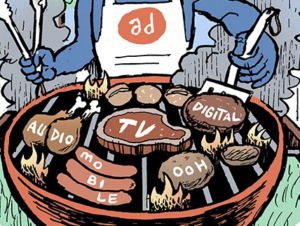“On TV And Video” is a column exploring opportunities and challenges in advanced TV and video.
Today’s column is written by David George, CEO of Pixability.
While advertisers now recognize the importance of CTV for reaching an enormous audience – 2020’s dramatic acceleration led to consumer user numbers exceeding 200 million – they are still concerned about how complicated it all seems and are still trying to figure out where to start.
Many advertisers are overwhelmed by the sheer number of streaming video apps, with hundreds already on the market and new launches happening on a daily basis. Just last month, Paramount Plus entered the game, and Univision unveiled its AVOD service PrendeTV. But despite the many challenges to CTV advertising at this stage of its adoption, it’s not quite as complicated as everyone thinks.
Doing more with less (and putting devices first)
To begin with, many of the biggest players in streaming are not ad-supported, allowing marketers to, more or less, forget about them in their CTV calculus. Of the top five streaming platforms in terms of viewership – Netflix, YouTube, Hulu, Amazon Prime, and Disney+ – only YouTube and Hulu are ad-supported.
After removing subscription-only services, YouTube represents 42% of viewing hours on CTV, while Hulu represents 28% with a large number of long-tail players representing the remaining 30% according to Comscore.
But an advertiser looking to invest in CTV can reach the entire CTV audience through a combination of YouTube, Hulu, and someone who can help reach that last group of longer-tail services like Pluto and Tubi. Rather than trying to strategize about the hundreds of individual players in the marketplace, this orientation makes CTV much more manageable.
Assuming an advertiser is already running CTV ads on YouTube and Hulu, how should they try to reach those dozens of long-tail players in the “Other” category that each represent about 1%-2% of CTV watch time? Instead of thinking about each of these services individually, advertisers are better served by considering the devices consumers are using to access CTV programming.
The top two devices used by US consumers to access streaming platforms on their TVs are Roku and Amazon Fire, respectively. An advertiser leveraging Roku and/or Amazon Fire’s CTV ad solutions could reach nearly the entire 30% of CTV viewing hours represented by long-tail streaming apps, efficiently solving the problem of having to go to each of the dozens of long-tail players individually. It’s actually not as daunting if you think about it that way.
What About Measurement?
Combining YouTube, Hulu, Amazon and Roku together can solve the issue of scale and make it easy for advertisers to reach the CTV audience. However, there still remains the challenge of finding specific audiences and measuring the results of this effort. There are bright spots to report here too:
- YouTube offers arguably the best targeting and measurement available on CTV based on the tools they’ve developed on other devices. YouTube (on the TV screen) leverages Google search data, app downloads, site visits and other key unique metrics for targeting purposes and is able to measure brand lift, store visits, and even revenue. These are all things you can’t do on other CTV platforms easily.
- Amazon Fire TV allows advertisers to target audiences based on their Amazon searches and shopping patterns. And it can measure the impact of CTV advertising on purchases. This direct attribution exceeds most anything available on traditional TV.
- Leveraging insights from platforms simultaneously can provide brands with even better information to determine whether their CTV campaigns are actually making a difference. Consider US footwear and apparel manufacturer Saucony, which worked with its agency iProspect to launch a new line of running shoes. They were able to track lift in purchase consideration on YouTube and Roku while simultaneously following consumers adding shoes to their shopping cart on Amazon. This gave them some robust full-funnel metrics, which many advertisers still don’t see as possible in CTV.
While there are still challenges for our industry to tackle as CTV advertising becomes increasingly important, some of the biggest hurdles are not quite as daunting as they seem. The recipe is actually pretty simple: (1) Start with the biggest ad-supported platforms, then add in Roku and/or Amazon devices that can reach the long tail. (2) Find the pockets of measurement and analytics that can tell you how well you’re really reaching your audience and driving action. (3) Test and iterate. Is it perfect? No. But it’s already an excellent place to start.
Follow David George (@dggeorge) and AdExchanger (@adexchanger) on Twitter.













